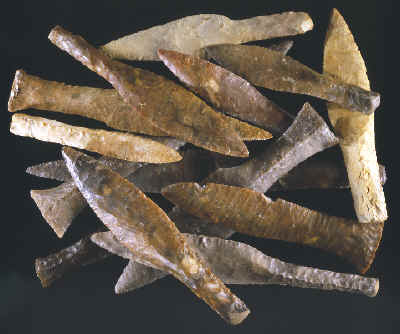|
"The daggers are
often marvels of skill in flint-chipping. Their form so closely resembles
that of metallic daggers, that some antiquaries are inclined to regard them
as copies of bronze daggers and therefore as not belonging to the Stone
Age".---1872, Sir John
Lubbock, Pre-Historic Times.

CLICK ON
PICTURE FOR LARGE IMAGE
DANISH
daggers
The
above statement was made by Sir John Lubbock in 1872 and is remarkably
accurate. For one
thing, Danish daggers have been impressing people for a long time with
their beautiful shapes and the skill that was obviously involved to make them. In fact,
there isn't anything quite like them any where else in the world.
It's also true that these people were making copies of metal
daggers in stone. They began to be made near the end of the Stone
Age or Late Neolithic period close to the time when some people in Europe
were beginning to develop tools made out of metal at the beginning of the
Bronze Age.
|
|
The first Danish daggers, known as type 1's, are uniformly thin
bifaces very similar to Morse or Ramey knives from Late Stone Age
sites in the central United States. The design of type I daggers
may have been influenced by similarly shaped examples that were
made by Bell-Beaker people in Great Briton. |
|
"REFERENCES"
1872,
Sir John Lubbock, "Pre-Historic Times, Ancient Remains and the
Manners & Customs of Modern Savages"
1952, "Danish Antiquities, II Late Stone Age", by P.V. Glob, pp.
122-123.
1970, "Tools of the Old Stone Age," by Jacques Bordaz, p. 109
1983, "The Search For humanity's Roots", by Herbert C. Kraft and
Gabriel DeCicco, pp. 58-59
1996, "The Oxford Companion To Archaeology, Beakers" by Brian M.
Fagan, pp. 88-90.
1998, "Chips, Vol. 10, #2, Thor's Toothpick, A Type IV-B Danish
Dagger", by D.C, Waldorf, pp. 12-18.
2001, "Chips, Vol. 13, #2, Type V-A Dagger", by D.C. Waldorf,
pp.10-17.
Personal communications with Dave Waldorf.
|